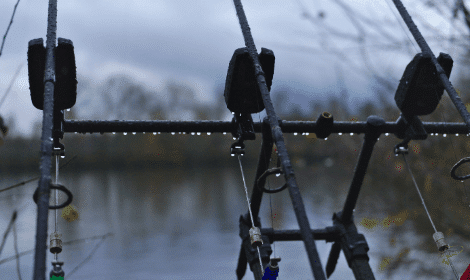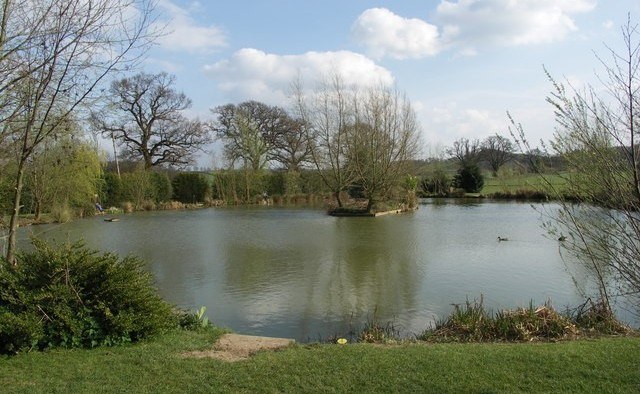
If you are feeling bold enough to head down to your local carp venue on the less than pleasant rainy days you might be wondering what your chances are of actually catching some carp, am I right?
Many believe that carp fishing will deter the fish from feeding which will result in a rather sluggish and unsuccessful day but actually this can be far from the case.
In a lot of cases carp fishing in the rain can produce substantial catches if you are brave enough to get out in the elements.
Quite often, this topic can seem rather complicated as there is a lot of other factors such as water temperature, season, fishing pressure and venue to name a few, that can have a direct effect if carp will be feeding in the rain.
Simply though, YES carp will and can feed in the rain and your chances of catching will very much still be there.
In this post I’m going to completely cover the topic of carp fishing in the rain and why I believe carp continue to feed throughout rainy spells to show you that carp can still be caught. The topics we are going to cover are as follows;
- Reduced Visibility
- Less Fishing Pressure
- Improved Water Oxygen Levels
- Organic Matter Run Off
- Colder Water Temperature
- Type of Venue
Reduced Visibility
Through periods of heavy and prolonged rain lots of water will run into the carp pond from surrounding surface water or any drains that are diverted into the pond.
This causes sediment to be transported into the water and can cause the water to turn a murky brown colour which will limit the visibility for feeding carp.
For a lot of fish species this would cause substantial issues as they primarily rely on sight for locating and consuming food.
Thankfully for us carp anglers though we do not need to worry and this decrease in visibility can actually increase your chances of catching.
Carp use their excellent sense of smell to locate food even in the murkiest of waters so don’t let bad water visibility turn you away.
As waters becomes murky and silty the fish will begin to move more freely as they feel more comfortable hidden in the dark coloured water.
Just as we can’t see the fish from the banks the fish will not see us peering in from the banks. Due to this fish will feed closer to us and the banks for longer periods of time giving us an improved chance of catching them.
Organic Matter Run Off
Just as these drains and surface run off make the water a muddy brown colour it will also wash organic matter and insects into the water. Guess what? Carp will be there waiting to feed on all these goods exactly where they run into the water.
If there are visible spots where drains from surrounding areas run into the fields and focused points where surface water is running into the water you can be sure that the carp will not be far away.
By focusing on these areas you can almost guarantee that the fish will be in the area which will obviously make them far easier to catch. Quite often the hardest part of carp fishing is knowing where to look for the fish.
Less Fishing Pressure
Unsurprisingly fewer anglers want to venture out in the rain to sit on a soggy bank in the hope of catching a few fish. Due to this you’ll find that venues are extremely quiet during spells of rainy and bad weather and generally packed when the weather is good.
If you decide to brave the elements on these rainy days you could find yourself with some great advantages with the reduced fishing pressure on the water.
Chances are you will have the pick of the pegs and manage to grab a promising peg that’ll increase your chances of catching.
Also, by having minimum lines and excess bait in the water the carp will feel more comfortable to move around freely looking for areas to feed.
As there are fewer beds of bait on the bottom the chances of the carp gathering around yours is a lot higher which will of course increase your chances of catching significantly.
Improved Water Oxygen Levels and Colder Water Temperatures
A well-known factor that influences how well your carp fishing session will go is oxygen levels in the water. When oxygen levels are high fish are more active and tend to be scouring the water for food.
During summer months when the water temperature is higher the water holds less oxygen hence why the carp are more lethargic and can quite often be founding basking in the sun in shallow areas of the water.
Throughout the winter water temperatures are a lot lower and oxygen in the water is far higher. The addition of some heavy rain can cause the water temperature to drop just enough to get the fish feeding again even in the summer.
On the other hand when oxygen levels in the water are low fish will be lethargic and less likely to be swimming around looking for their next meal.
When the rain stars oxygen levels in the water rise as the water temperature begins to drop slightly. This gets the carp moving and looking for their next meal which will increase your chances of catches them.
Air Pressure
Air pressure also has a massive effect on carp fishing as this has a direct impact on the oxygen levels in the water. Are you starting to see a pattern here? Yep high oxygen levels mean more chances of catching fish.
During summer when the skies are blue and clear the air pressure is high and hence there is less oxygen in the water as we discussed previously.
So when the air pressure is low rising air cools which is likely to condense into water vapor to from clouds which inevitable turns to rain.
During these spells of low air pressure the water is more oxygenated and as we mentioned the carp will be energized and on the look out for food.
Quite often wind comes with the rain which also helps to oxygenate the water but you can read all about that in this post about carp fishing in windy conditions.
Just keep in mind; low pressure results in rain and cloudy skies which more often than not will increase your chances of catching fish.
So when you see the weather and notice a low pressure system moving in consider getting yourself on the banks instead of sitting at home!
Venue

Although all this stuff seems simple enough I’m sure you will all know that fish in different venues very rarely react the same to external factors such as weather.
Carp react differently across venues mainly due to depths and features across the water, if there is any water flowing in, angling pressure and what natural food sources are available around the water.
Due to this it is extremely hard to dictate if spells of rain will have a positive or negative effect on the venue you plan to fish. That being said this list will provide a rough guide for you to make your mind up yourself!
Another point to add is increased current in the water. Not all venues have water supplies running directly into the body of water so this is depended entirely on what venue you are planning to fish.
If streams are running into the water then a downpour of rain will increase this flow.
If this is the case these streams will bring down organic matter and vegetation that the carp will wait for. The carp will usually sit in slack water beside this current so make sure your bait is at the ready!
Variation Depending on Season
Although fishing in the rain would seem to be a great opportunity from the list above it is never that simple. Depending on what season you are fishing rain can have either a positive or negative impact. This is mainly due to the condition the water has been at terms of temperature, visibility and how the weather has been.
Rain in the Summer
Generally during the summer months water temperatures will be high for prolonged periods of time and high pressure weather systems are more likely.
Due to this oxygen levels in the water are more than likely going to be lower so a short burst of rain from a low pressure system can substantially increase oxygen levels rapidly which will get the carp feeding again.
In the summer months organic matter, natural vegetation and natural foods are a lot more common and will be washed into the water from the surrounding banks with a burst of rain.
Rain in the Winter and Spring
On the other hand rain in the winter might not be so promising. Not only are the temperature a lot colder for us to endure without any nuisance rain but water temperatures are also a lot colder with the fish usually residing in deep sections of the water.
As spring arrives and the fish start to resurface and look for food a short burst of rain can drop the temperature too much and send them back into the depths which will limit your chances of catching.
Natural food sources are also scarce during this time so even if it does rain the chances of carp hanging around surface water running into the venue are extremely slim as they will know there is not a lot of organic matter to consume.
So as a general rule of thumb rain the summer can provide an extremely good opportunity to get onto the banks and catch some fish but during the winter months I would tend to avoid fishing during the rain.
That’s All!
I’m sure you can see that carp fishing is not something that can be avoided and it can actually provide a great opportunity for increasing catch rates.
If you have anything to add or decide to get yourself out on the water for a session in the rain please let me know how you got on below and give me your opinion on the topic.
If you are interested in learning more about carp behaviours take a read at my post on why carp jump!


